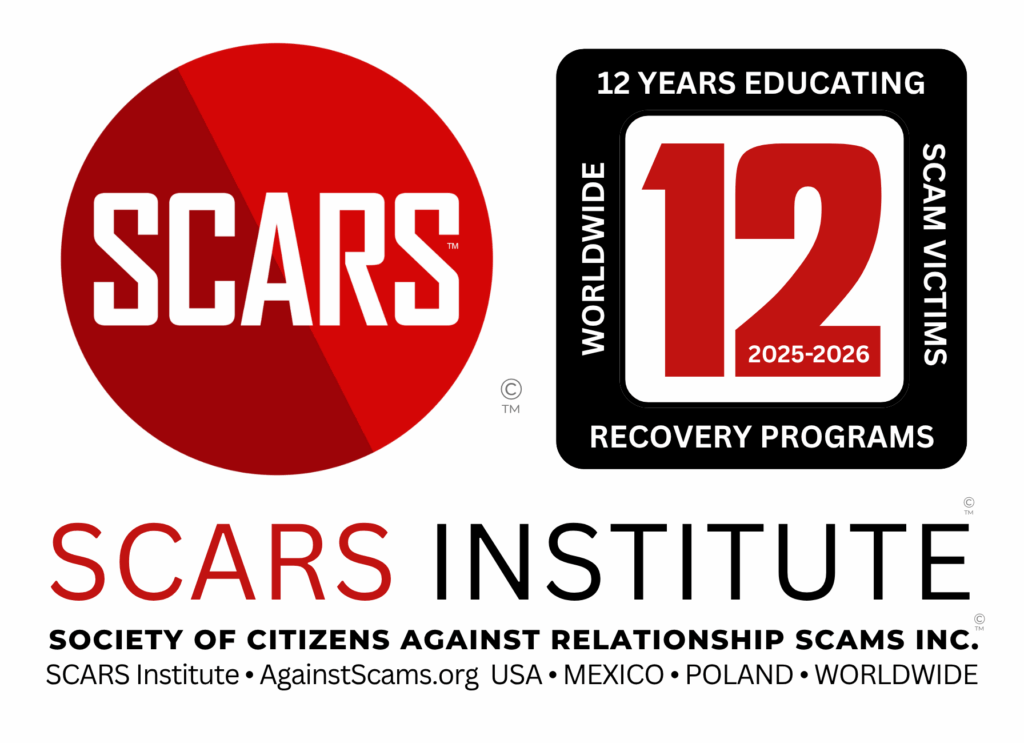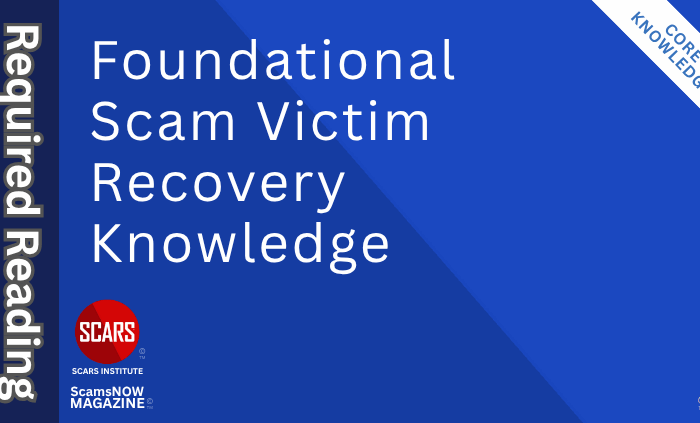
Transform Your Survivor’s Stories into an Epic Campfire Saga
The Problem of Telling Your Stories for Scam Victims: Transform them into Epic Stories of Heroism and Defeated Monsters
Primary Category: Scam Victim Recovery Psychology / Scam Victim Recovery Philosophy
Author:
• Tim McGuinness, Ph.D., DFin, MCPO, MAnth – Anthropologist, Scientist, Polymath, Director of the Society of Citizens Against Relationship Scams Inc.
• Debby Montgomery Johnson, President and CEO of BenfoComplete.com, Online Scam/Fraud Survivors Advocate, Author, Keynote Speaker, Trainer, Podcast Host, USAF Veteran, Chair and Director of the Society of Citizens Against Relationship Scams Inc.
Author Biographies Below
About This Article
For victims of sophisticated scams, the path to recovery can be powerfully aided by reframing their personal story from one of shame into a heroic saga. This approach encourages survivors to cast the perpetrators not as simple tricksters, but as formidable monsters or expert thieves who deploy calculated tactics of pressure and deceit. In this narrative, the victim becomes the resilient hero who endured a treacherous battle, ultimately discovering the plot and courageously standing their ground. Adopting this epic storytelling model serves as a vital tool for personal healing, transforming a tale of defeat into one of survival, wisdom, and pride. Beyond the individual, this method has a crucial social benefit; by crafting a compelling and detailed account of their struggle and triumph, survivors can effectively educate the public on criminal methods, turning a personal trauma into an empowering lesson in prevention for the entire community.
Note: This article is intended for informational purposes and does not replace professional medical advice. If you are experiencing distress, please consult a qualified mental health professional.

The Problem of Telling Your Stories for Scam Victims: Transform them into Epic Stories of Heroism and Defeated Monsters
Introduction
Your story is not one to be ashamed of; you killed monsters and slayed dragons. You survived!
Your scam did not write a tale of defeat. A scam set the stage for an epic. The same facts can be read as loss or as legend, and the choice decides which version travels.
When you tell your story, don’t tell it as something to be whispered; tell it as a saga of trial and victory in battle. Stand tall, speak clearly, and let courage take the lead. Friends will hear the grit in each decision. Strangers will hear the outline of a quest through kraken-infested waters. A steady voice turns scattered memories into an epic saga of you vs. true monsters.
This is not a tragedy; this is a campfire story. Not a confession, but a bold tale of international intrigue. Expert professional thieves used time, pressure, and lies, and they trained for it. They had you on the run for a time, but then you discovered the plot, and you turned the tables on them and refused to give them more of what they wanted from you. That truth says you stood up to the monsters and held your ground. It says plenty about the storm that passed and the person who kept going. Claim the role of the hero who learned, adapted, and came home wiser. Name the traps, show the turns, and be bold in the telling. Speak without apology, let the hard parts stand in daylight, and let your pride rise where survival and learning took root.
“After nourishment, shelter and companionship, stories are the thing we need most in the world.”
― Philip Pullman“Your tale, sir, would cure deafness.”
― William Shakespeare, The Tempest
Look, This Stuff Matters
As a crime victim, your story matters. Not just to you but to everyone you tell it too.
It matters because it was a real journey through hell and back. An epic of consequence that involved risk to your very life.
Yet most scam victims tell their stories as though they are ashamed of their story, ashamed of who they are, and how they survived. And what is worse, they avoid one of the most powerful tools to help them regain perspective and advance their recovery: storytelling. Your story matters, not just to other survivors, though it does, but also to regular people who have never been scammed. However, more than all of them, it matters to you! You should be proud of your survival, and your story is how you display that pride.
Stop thinking of your story as a painful necessity, and transform it into that uniquely human thing, a story worth telling.
“You may tell a tale that takes up residence in someone’s soul, becomes their blood and self and purpose. That tale will move them and drive them and who knows that they might do because of it, because of your words. That is your role, your gift.”
― Erin Morgenstern“Tell the story that’s been growing in your heart, the characters you can’t keep out of your head, the tale story that speaks to you, that pops into your head during your daily commute, that wakes you up in the morning.”
― Jennifer Weiner
The Power of Storytelling: A Timeless Bond Between Teller and Listener
Storytelling is a fundamental aspect of human culture, woven into the fabric of our existence from time immemorial. From the moment humans gained language we were telling stories. Sometimes tragic, sometimes epic and boundless, sometimes funny. But storytelling is what fundamentally makes us human. And our stories matter, and so does yours.
It is a universal language that transcends barriers of time, space, and culture, offering profound benefits to both the teller and the listener. From an anthropological perspective, storytelling has been a cornerstone of human societies, serving as a means of preserving history, transmitting knowledge, and fostering social cohesion. In modern terms, it continues to be a powerful tool for communication, education, and personal growth. Are you using your story in this way?
“No, no! The adventures first, explanations take such a dreadful time.”
― Lewis Carroll, Alice’s Adventures in Wonderland / Through the Looking-Glass“Once upon a time there was what there was, and if nothing had happened there would be nothing to tell.”
― Charles de Lint, Dreams Underfoot
The Anthropological Perspective
Preserving History and Culture
From an anthropological standpoint, storytelling has been the primary method for preserving history and cultural heritage. Oral traditions, passed down through generations, have ensured that the stories, beliefs, and values of a community are not lost to time. These narratives often encapsulate the collective wisdom and experiences of a people, providing a sense of continuity and identity. For example, indigenous communities around the world have relied on storytelling to maintain their cultural practices and spiritual beliefs, even in the face of external pressures and changes.
Transmitting Knowledge and Skills
Storytelling has also been a crucial means of transmitting knowledge and skills. Through stories, elders have taught younger generations about survival techniques, agricultural practices, and social norms. These narratives often embed practical information within engaging and memorable contexts, making it easier for listeners to absorb and retain the knowledge. For instance, many African cultures use proverbs and fables to impart moral lessons and life skills, ensuring that these teachings are passed on effectively.
Fostering Social Cohesion
One of the most significant functions of storytelling from an anthropological perspective is its role in maintaining social cohesion. Stories bring people together, creating a shared understanding and a sense of belonging. They provide a platform for discussing common experiences, resolving conflicts, and reinforcing social bonds. In many societies, storytelling sessions are communal events where individuals come together to share, listen, and connect, strengthening the fabric of their community.
“Listen, and you will realize that we are made not from cells or from atoms. We are made from stories.”
― Mia Couto“Doubt is a question mark; faith is an exclamation point. The most compelling, believable, realistic stories have included them both.”
― Criss Jami, Killosophy
The Modern Perspective
Communication and Connection
In modern terms, storytelling remains a powerful tool for communication and connection. It allows individuals to express their thoughts, feelings, and experiences in a way that resonates with others. Whether through personal anecdotes, fictional narratives, or media content, stories help us understand and relate to one another on a deeper level. In an increasingly digital world, storytelling has evolved to include new mediums such as blogs, podcasts, and social media, reaching a global audience and breaking down geographical barriers.
Education and Learning
Storytelling continues to be an effective method of education and learning. Teachers and educators use stories to make complex concepts more accessible and engaging. Narratives can simplify abstract ideas, making them relatable and easier to comprehend. For example, historical events can be brought to life through storytelling, helping students connect with the past and understand its relevance to the present. Additionally, storytelling in corporate settings is used to convey company values, mission, and vision, making them more memorable and impactful.
Personal Growth and Healing
For both the teller and the listener, storytelling can be a path to personal growth and healing. Sharing one’s story can be therapeutic, allowing individuals to process their experiences, gain perspective, and find meaning in their journey. Listeners, in turn, can draw inspiration and strength from the stories of others, realizing that they are not alone in their struggles. Support groups and therapeutic settings often utilize storytelling as a tool for healing and resilience, providing a safe space for individuals to share and connect.
“Stories have to be told or they die, and when they die, we can’t remember who we are or why we’re here.”
― Sue Monk Kidd, The Secret Life of Bees“Authors do not choose a story to write, the story chooses us.”
― Richard Denney
The Benefits for the Teller
Self-Expression and Identity
For the storyteller, the act of creating and sharing stories is an expression of self and identity. It allows individuals to explore their thoughts, emotions, and experiences, gaining a deeper understanding of themselves in the process. Through storytelling, tellers can articulate their unique perspective, values, and beliefs, contributing to their personal growth and self-discovery. This self-expression can be empowering, boosting confidence and self-esteem.
Connection and Influence
Storytelling also provides tellers with a means of connecting with and influencing their audience. By crafting compelling narratives, storytellers can inspire, educate, and motivate others. This influence can extend beyond immediate interactions, as stories have the power to resonate with people long after they have been told. For example, authors, filmmakers, and public speakers use storytelling to shape opinions, drive social change, and leave a lasting impact on their audience.
Creativity and Innovation
Engaging in storytelling stimulates creativity and innovation. Tellers must continually find new ways to capture their audience’s attention and convey their message effectively. This creative process can lead to unique insights, fresh perspectives, and innovative solutions. Whether through writing, performing, or digital storytelling, the act of creating narratives encourages tellers to think outside the box and push the boundaries of their imagination.
“If history were taught in the form of stories, it would never be forgotten.”
― Rudyard Kipling, The Collected Works“Who will be lost in the story we tell ourselves? Who will be lost in ourselves? A story, after all, is a kind of swallowing. To open a mouth, in speech, is to leave only the bones, which remain untold.”
― Ocean Vuong, On Earth We’re Briefly Gorgeous
The Benefits for the Listener
Empathy and Understanding
For the listener, storytelling fosters empathy and understanding. By immersing themselves in the experiences of others, listeners can develop a deeper appreciation for different perspectives and walk in someone else’s shoes. This empathetic connection can lead to increased tolerance, compassion, and a more inclusive worldview. For example, reading diverse literature or watching films from different cultural backgrounds can broaden one’s understanding and challenge preconceived notions.
Inspiration and Motivation
Listening to stories can be a source of inspiration and motivation. Narratives often highlight the resilience, courage, and achievements of individuals, providing listeners with role models and aspirations. Whether it’s a biography of a historical figure, a tale of overcoming adversity, or a fictional hero’s journey, stories can ignite a spark within listeners, encouraging them to pursue their own goals and dreams with renewed vigor.
Knowledge and Wisdom
Storytelling is also a vehicle for transmitting knowledge and wisdom. Through stories, listeners can gain insights into various subjects, from science and history to philosophy and ethics. Narratives often embed lessons and teachings within engaging plots, making complex ideas more accessible and memorable. For instance, Aesop’s fables use animal characters to convey moral lessons, teaching listeners valuable life skills and ethical principles.
“My father used to say that stories are part of the most precious heritage of mankind.”
― Tahir Shah, In Arabian Nights: A Caravan of Moroccan Dreams“It’s important to remember that we all change each other’s minds all the time. Any good story is a mind-altering substance.”
― Hank Green, A Beautifully Foolish Endeavor
The Power of Storytelling for Crime Victims, Especially Scam Victims
Storytelling plays a crucial role in the healing and empowerment of crime victims, particularly those who have fallen prey to scams. For scam victims, the act of sharing their experiences through storytelling can be a transformative journey, offering a path to recovery, validation, and resilience.
Healing and Validation
For scam victims, the emotional impact of their experience can be profound and long-lasting. Often, victims feel a sense of shame, embarrassment, and isolation, believing that they are alone in their suffering. Storytelling provides a platform for these individuals to break their silence and share their stories with others. By doing so, they can find validation and understanding, realizing that their experiences are legitimate and that they are not to blame. This validation is a crucial step in the healing process, helping victims to process their emotions and begin to rebuild their sense of self-worth and dignity.
Breaking the Cycle of Isolation
One of the most insidious effects of scams is the isolation they can create. Victims may feel too ashamed to discuss their experiences, even with close friends and family. This isolation can exacerbate feelings of depression, anxiety, and hopelessness. By sharing their stories, victims can break this cycle of isolation and connect with others who have had similar experiences. Support groups and online communities dedicated to scam survivors provide safe spaces where individuals can share their narratives, offer mutual support, and gain a sense of belonging. This connection with others can be incredibly healing, reminding victims that they are not alone in their journey and that there is a community ready to support them.
Empowerment Through Sharing
Sharing one’s story can be an empowering act for scam victims. It allows them to take control of their narrative, transforming from a passive victim into an active participant in their own healing. By choosing to share their experiences, victims can reclaim their power and assert their resilience. This empowerment is further enhanced when victims use their stories to educate others about the tactics used by scammers, helping to prevent future victims and raising awareness about the issue. Through workshops, blog posts, or social media campaigns, scam survivors can turn their pain into purpose, using their experiences to make a positive impact and protect others from similar harm.
Education and Prevention
Storytelling is also a powerful tool for educating the public about the realities of scams and the importance of staying vigilant. By sharing their personal accounts, scam victims can provide insights into the psychological and emotional manipulation tactics used by scammers. These firsthand accounts can be more compelling and relatable than generic warnings or statistics, helping others to recognize the signs of a scam and take proactive measures to protect themselves.
Raising Awareness
Raising awareness about scams is crucial in preventing future victims. Scam survivors can play a vital role in this effort by sharing their stories through various media platforms. Whether through interviews, articles, or social media posts, their narratives can reach a wide audience and shed light on the often-hidden world of scams. By highlighting the emotional and financial toll that scams can take, survivors can encourage others to be more cautious and skeptical, reducing the likelihood of them falling prey to similar schemes. Additionally, their stories can inspire others to report scams and support efforts to bring scammers to justice.
Educating the Public
Educating the public about the tactics used by scammers is another important aspect of storytelling for scam victims. Through their personal experiences, survivors can illustrate the common techniques employed by scammers, such as creating a sense of urgency, exploiting emotions, or using fake identities. This education can help others to recognize these red flags and take steps to protect themselves. For example, a survivor might share how they were manipulated into providing personal information or making a financial transaction, providing specific details about the scammer’s approach. This level of detail can be invaluable in helping others to identify and avoid similar situations.
Building Resilience
The process of sharing one’s story and connecting with others can significantly contribute to building resilience in scam victims. Resilience is the ability to bounce back from adversity and adapt to challenging circumstances. For scam survivors, building resilience is essential for moving forward and reclaiming their lives.
Finding Strength in Vulnerability
Finding strength in vulnerability is a key aspect of building resilience through storytelling. By openly sharing their experiences, scam victims can confront their vulnerabilities and turn them into sources of strength. This vulnerability allows them to connect with others on a deeper level, fostering empathy and understanding. As they share their journeys of healing and growth, survivors can inspire others to embrace their own vulnerabilities and find the courage to seek support and take steps towards recovery. This shared vulnerability creates a supportive community where individuals can learn from one another and grow together.
Learning and Growing
The act of storytelling itself is a learning and growing process for scam victims. As they reflect on their experiences and articulate their stories, survivors gain new insights and perspectives. They may discover patterns in their thinking or behavior that contributed to their vulnerability to scams, allowing them to develop strategies for personal growth and self-improvement. Additionally, engaging with others’ stories can provide survivors with new ideas and approaches to healing, encouraging them to explore different paths and techniques for building resilience. This continuous learning and growth help survivors to evolve and adapt, becoming more resilient and better equipped to handle future challenges.
“A storyteller makes up things to help other people; a liar makes up things to help himself.”
― Daniel Wallace, The Kings and Queens of Roam“Whatever story you’re telling, it will be more interesting if, at the end you add, “and then everything burst into flames.”
― Brian P. Cleary, You Oughta Know By Now
Crafting a Compelling Narrative: Embellishing Your Story for Impact
We understand that in the first few months after the scam ends, you are in pure survival mode, but as time goes by and you regain control in your life, it is time to start thinking about telling the whole story.
For scam victims, sharing their story can be a powerful way to connect with others, raise awareness, and inspire change. However, to truly capture an audience’s attention and make a lasting impact, it’s important to craft a compelling narrative that resonates on an emotional and intellectual level. Here are some strategies to help scam victims embellish their stories effectively.
Understanding Your Audience
Before you begin, it’s crucial to understand who your audience is and what will resonate with them. Are you speaking to a group of potential scam victims, a support group, or a broader public audience?
Tailoring your story to your specific audience can make it more relatable and impactful. For example:
-
- If you’re speaking to a group of potential victims, you might focus more on the warning signs and how to spot a scam.
- If you’re addressing a support group, you might emphasize the emotional journey and the path to healing.
Identifying Key Emotions
Identify the key emotions you want your audience to feel. Do you want them to feel empathy, outrage, or inspiration? By focusing on these emotions, you can structure your story to evoke the desired response. For instance, if you want to inspire others, you might highlight your personal growth and the positive changes you’ve made since the scam. If you want to evoke empathy, you might share the most vulnerable and challenging parts of your experience.
Creating a Hook
A strong opening can capture your audience’s attention and set the tone for your entire story. Consider starting with a surprising fact, a powerful quote, or a vivid description of a pivotal moment in your experience. For example, you might begin with, “I never thought I would be the kind of person who falls for a scam, but on that fateful day, I found myself trapped in a web of deceit that would change my life forever.” This kind of hook draws the listener in and makes them eager to hear more.
Structuring Your Narrative
A well-structured narrative has a clear beginning, middle, and end, with a logical flow that keeps the audience engaged. Here are some elements to consider when structuring your story.
The Setup
The setup introduces the context and background of your story. This is where you set the stage for your experience, providing enough detail for the audience to understand the situation without overwhelming them with too many specifics. For example, you might describe your life before the scam, your expectations, and any relevant personal or professional circumstances.
The Conflict
The conflict is the heart of your story, where you describe the scam and the challenges you faced. Be specific about the tactics used by the scammer, the emotional manipulation, and the financial or personal losses you incurred. Use vivid details and sensory language to make the experience come alive for your audience. For instance, you might describe the exact words used by the scammer, the feelings of dread and confusion you experienced, and the moment you realized you had been deceived.
The Resolution
The resolution is where you share how you coped with the aftermath of the scam and the steps you took to recover. This part of your story should focus on your journey to healing, the support you received, and the lessons you learned. You might also include any actions you took to seek justice or prevent others from falling victim to similar scams. Ending on a note of hope and resilience can leave a powerful impression on your audience.
Enhancing with Details and Dialogue
Adding rich details and dialogue can make your story more engaging and memorable. Here are some techniques to enhance your narrative with these elements.
Sensory Details
Incorporating sensory details can help your audience visualize and feel your experience more intensely. Describe the sights, sounds, smells, and emotions associated with key moments in your story. For example, you might describe the claustrophobic feeling of being trapped in a cycle of deception, the sound of your heart racing as you realized the scam, or the bitter taste of betrayal. These details create a more immersive experience for your listeners.
Dialogue
Including dialogue can bring your story to life and make it more dynamic. Quote the exact words used by the scammer, your own internal monologue, or conversations with friends and family. Dialogue can also be used to highlight the emotional impact of the scam, such as a heartfelt conversation with a loved one or a moment of self-reflection. For instance, you might recall a scammer’s persuasive pitch or a supportive friend’s encouraging words, using these exchanges to illustrate the depth of your experience.
Connecting to Universal Themes
To make your story truly resonant, connect it to universal themes that your audience can relate to, such as trust, betrayal, resilience, or the human capacity for growth. By tying your personal experience to these broader concepts, you can create a deeper emotional connection and make your story more impactful.
Themes of Trust and Betrayal
Trust and betrayal are powerful themes that can evoke strong emotions in your audience. Explore how the scam shattered your trust and the sense of betrayal you felt. You might discuss the impact on your relationships, your ability to trust others, and the steps you took to rebuild that trust. Sharing these themes can help your audience understand the profound effect of scams on an individual’s life and psyche.
The Journey of Resilience
The journey of resilience is another universal theme that can inspire and uplift your audience. Highlight the challenges you faced in the aftermath of the scam and the strategies you employed to overcome them. Share the moments of doubt and the breakthroughs, the support you received, and the strength you discovered within yourself. By focusing on resilience, you can show your audience that healing and growth are possible, even in the face of significant adversity.
“Thus I rediscovered what writers have always known (and have told us again and again): books always speak of other books, and every story tells a story that has already been told.”
― Umberto Eco, Postscript to the Name of the Rose“If a story is not about the hearer he [or she] will not listen . . . A great lasting story is about everyone or it will not last. The strange and foreign is not interesting–only the deeply personal and familiar.”
― John Steinbeck, East of Eden
Conclusion
Storytelling is a timeless art that continues to play a vital role in human society, offering profound benefits to both the teller and the listener. From an anthropological perspective, it has been a means of preserving culture, transmitting knowledge, and fostering social cohesion. In modern terms, it remains a powerful tool for communication, education, and personal growth. Whether through ancient oral traditions or contemporary digital platforms, stories have the unique ability to connect, inspire, and transform. By embracing the power of storytelling, we can enrich our lives, deepen our understanding of the world, and create a more empathetic and connected global community.
For crime victims, especially scam survivors, storytelling is a powerful tool for healing, empowerment, and education. By sharing their experiences, victims can find validation, break the cycle of isolation, and reclaim their power. Their stories serve as a beacon of awareness, educating the public about the realities of scams and the importance of staying vigilant. Moreover, the process of storytelling contributes to building resilience, helping survivors to find strength in vulnerability and continue learning and growing. Through the power of storytelling, scam victims can transform their pain into purpose, using their experiences to make a positive impact and support others on their journey to recovery and resilience.
Embellishing your story with these techniques can help you create a compelling narrative that captures your audience’s attention and leaves a lasting impact. By understanding your audience, structuring your narrative effectively, enhancing it with details and dialogue, and connecting to universal themes, you can transform your personal experience into a powerful story of resilience and hope. Remember, your story has the power to educate, inspire, and support others, so embrace the opportunity to share it with confidence and authenticity.
So just imagine you are sitting by a campfire somewhere and telling an epic tale of fighting off trolls, defending yourself from dragons or zombies. Your story is every bit as much one worthy of a Viking Saga! Add a bit of spice, grab their attention, and spin your yarn of desperation and triumph from the dangers of the digital world, as only you can do.
“I think the best stories always end up being about the people rather than the event, which is to say character-driven.”
― Stephen King, On Writing: A Memoir of the Craft“Things worth telling – take time”
― Nicholas Denmon“That’s what we storytellers do. We restore order with imagination. We instill hope again and again and again.”
― Kelly Marcel & Sue Smith

Glossary
- Act Structure — This term refers to arranging a story into beginning, middle, and end. A clear structure helps a listener track events and emotions without confusion. A survivor’s timeline becomes easier to share when moments are grouped by setup, conflict, and resolution.
- Agency — Agency describes the capacity to make choices after harm. A survivor demonstrates agency by deciding what to tell, what to withhold, and whom to trust. Naming those choices shows growth rather than defeat.
- Arc — An arc is the path a person or story travels from one state to another. A survivor’s arc may move from shock to clarity to steadier footing. Mapping that movement helps others understand progress.
- Authentic Voice — Authentic voice is the sound of truth in a person’s words. It does not require perfect language, only honest detail. Listeners respond to the steady tone of lived experience.
- Audience — Audience means the specific people who hear a story. Different groups need different framing, such as warning signs for the public or feelings for a support circle. Matching the message to the audience keeps the story effective and respectful.
- Campfire Framing — Campfire framing treats the story as a shared human tale rather than a confession. The teller invites listeners to sit close, listen carefully, and learn. This approach reduces shame and strengthens connection.
- Character — Character refers to the people in a story, including the survivor, allies, and offenders. Clear roles prevent confusion and reduce blame. Defining each person’s actions supports accountability.
- Character Arc — A character arc shows how a person changes across the story. A survivor may grow from isolated to connected or from fearful to informed. This change signals learning and recovery.
- Climax — The climax is the peak moment of tension or realization. It may be the instant the scam becomes clear or the first report filed. Marking this moment gives the story a center.
- Closure — Closure is the sense of settling that follows action. It does not erase loss but shows what steps were taken and what support continues. Listeners learn what recovery looks like today.
- Conflict — Conflict is the problem that drives the story. In scams, conflict often includes deception, pressure, and loss. Naming the conflict plainly helps the audience follow cause and effect.
- Consent to Share — Consent to share is the decision to tell a story with awareness of risks and benefits. A survivor can set limits on names, dates, and platforms. Clear consent protects privacy and dignity.
- Dialogue — Dialogue is spoken exchange quoted in a story. Including exact phrases from messages or calls can reveal manipulation techniques. Short, accurate lines carry strong impact.
- Embarrassment Reframe — This practice turns embarrassment into information. Instead of hiding errors, a survivor explains how tactics worked and what changed afterward. The shift from shame to learning helps others stay safer.
- Embellishment Ethics — Embellishment ethics set bounds for creative detail. Color can heighten mood, but facts stay correct, especially amounts, timelines, and identities. Honesty builds trust and credibility.
- Hook — A hook is the opening that captures attention. It may be a vivid moment, a striking line, or a question. A strong hook signals that the story has purpose.
- Hero’s Journey — The hero’s journey frames the survivor as a central figure who faces trials, gains tools, and returns wiser. The model does not glorify harm. It highlights choice, endurance, and learning.
- Imagery — Imagery uses sensory detail so listeners can picture events. Descriptions of screens, rooms, and physical feelings make the account real. Careful detail helps memory and meaning.
- Lesson Learned — A lesson learned is a specific takeaway earned through experience. It can cover boundaries, verification, or financial hygiene. Stating lessons turns pain into public value.
- Monsters as Metaphor — Monsters as metaphor describes offenders and tactics in symbolic terms. Dragons or trolls stand in for pressure and lies. Metaphor offers distance while honoring truth.
- Narrative Pacing — Narrative pacing is the speed at which events unfold in the telling. Slowing down at key points aids clarity, while moving briskly through routine steps keeps interest. Balanced pacing reduces overwhelm.
- Narrator Stance — Narrator stance is the position from which the story is told. A calm, factual stance supports credibility even when emotion is present. Consistent stance helps listeners stay with the story.
- Plot Point — A plot point is an event that changes direction. First payment, a bank alert, or a friend’s question can be turning marks. Selecting these moments gives the story shape.
- Privacy Redaction — Privacy redaction removes sensitive details that could invite harm. Redacted items may include full names, account numbers, or locations. Safety remains part of responsible storytelling.
- Protagonist — The protagonist is the main actor in the story. In scam tales, the survivor holds this role with dignity and agency. Centering the protagonist affirms worth.
- Resolution — Resolution covers actions taken after discovery. It may include reporting, counseling, and support networks. Resolution shows that life continues with new tools.
- Scene — A scene is a contained moment set in time and place. Good scenes include who was present, what was said, and what changed. Scenes stack into a clear narrative path.
- Sensory Detail — Sensory detail names what was seen, heard, and felt. It grounds the story in concrete experience. Small, accurate details increase trust and memory.
- Shame Resilience — Shame resilience is the ability to speak despite fear of judgment. It grows when people are met with empathy and facts. Repeated telling in safe settings strengthens this skill.
- Stakes — Stakes define what could be lost or gained. Money, reputation, and relationships are common stakes in scams. Clear stakes explain pressure and choices.
- Support Network — A support network includes people and services that assist recovery. Family, peers, counselors, and advocates often play roles. Naming them models help-seeking for others.
- Theme — Theme is the central idea that runs through a story. Common themes include trust, courage, and renewal. A clear theme ties events together.
- Tone — Tone is the emotional color of the telling. A steady, compassionate tone invites listening and reduces blame. Tone can be firm without anger and warm without denial.
- Trigger Warning — A trigger warning alerts listeners to content that may distress. It prepares the audience and shows care. Simple heads-up language can prevent harm.
- Turning Point — A turning point is the moment the path shifts. It could be a final refusal, a filed report, or a supportive call. Turning points demonstrate change in action.
- Validation — Validation is the recognition that harm occurred and feelings make sense. It can come from peers, professionals, or self-acknowledgment. Validation reduces isolation and supports healing.
- Voice Rehearsal — Voice rehearsal is the practice of telling the story in safe spaces. Rehearsal builds confidence, checks pacing, and refines wording. Over time, the telling becomes clear and calm.
Author Biographies
Please Rate This Article
Please Leave Us Your Comment Below
Also, tell us of any topics we might have missed.
-/ 30 /-
What do you think about this?
Please share your thoughts in a comment above!
ARTICLE RATING
TABLE OF CONTENTS
CATEGORIES
U.S. & Canada Suicide Lifeline 988
![NavyLogo@4x-81[1] Transform Your Survivor's Stories into an Epic Campfire Saga - 2025](https://scamsnow.com/wp-content/uploads/2025/04/NavyLogo@4x-811.png)
ARTICLE META
Important Information for New Scam Victims
- Please visit www.ScamVictimsSupport.org – a SCARS Website for New Scam Victims & Sextortion Victims.
- SCARS Institute now offers its free, safe, and private Scam Survivor’s Support Community at www.SCARScommunity.org – this is not on a social media platform, it is our own safe & secure platform created by the SCARS Institute especially for scam victims & survivors.
- SCARS Institute now offers a free recovery learning program at www.SCARSeducation.org.
- Please visit www.ScamPsychology.org – to more fully understand the psychological concepts involved in scams and scam victim recovery.
If you are looking for local trauma counselors, please visit counseling.AgainstScams.org
If you need to speak with someone now, you can dial 988 or find phone numbers for crisis hotlines all around the world here: www.opencounseling.com/suicide-hotlines
Statement About Victim Blaming
Some of our articles discuss various aspects of victims. This is both about better understanding victims (the science of victimology) and their behaviors and psychology. This helps us to educate victims/survivors about why these crimes happened and not to blame themselves, better develop recovery programs, and help victims avoid scams in the future. At times, this may sound like blaming the victim, but it does not blame scam victims; we are simply explaining the hows and whys of the experience victims have.
These articles, about the Psychology of Scams or Victim Psychology – meaning that all humans have psychological or cognitive characteristics in common that can either be exploited or work against us – help us all to understand the unique challenges victims face before, during, and after scams, fraud, or cybercrimes. These sometimes talk about some of the vulnerabilities the scammers exploit. Victims rarely have control of them or are even aware of them, until something like a scam happens, and then they can learn how their mind works and how to overcome these mechanisms.
Articles like these help victims and others understand these processes and how to help prevent them from being exploited again or to help them recover more easily by understanding their post-scam behaviors. Learn more about the Psychology of Scams at www.ScamPsychology.org
SCARS INSTITUTE RESOURCES:
If You Have Been Victimized By A Scam Or Cybercrime
♦ If you are a victim of scams, go to www.ScamVictimsSupport.org for real knowledge and help
♦ SCARS Institute now offers its free, safe, and private Scam Survivor’s Support Community at www.SCARScommunity.org – this is not on a social media platform, it is our own safe & secure platform created by the SCARS Institute especially for scam victims & survivors.
♦ Enroll in SCARS Scam Survivor’s School now at www.SCARSeducation.org
♦ To report criminals, visit https://reporting.AgainstScams.org – we will NEVER give your data to money recovery companies like some do!
♦ Follow us and find our podcasts, webinars, and helpful videos on YouTube: https://www.youtube.com/@RomancescamsNowcom
♦ Learn about the Psychology of Scams at www.ScamPsychology.org
♦ Dig deeper into the reality of scams, fraud, and cybercrime at www.ScamsNOW.com and www.RomanceScamsNOW.com
♦ Scam Survivor’s Stories: www.ScamSurvivorStories.org
♦ For Scam Victim Advocates visit www.ScamVictimsAdvocates.org
♦ See more scammer photos on www.ScammerPhotos.com
You can also find the SCARS Institute’s knowledge and information on Facebook, Instagram, X, LinkedIn, and TruthSocial
Psychology Disclaimer:
All articles about psychology and the human brain on this website are for information & education only
The information provided in this and other SCARS articles are intended for educational and self-help purposes only and should not be construed as a substitute for professional therapy or counseling.
Note about Mindfulness: Mindfulness practices have the potential to create psychological distress for some individuals. Please consult a mental health professional or experienced meditation instructor for guidance should you encounter difficulties.
While any self-help techniques outlined herein may be beneficial for scam victims seeking to recover from their experience and move towards recovery, it is important to consult with a qualified mental health professional before initiating any course of action. Each individual’s experience and needs are unique, and what works for one person may not be suitable for another.
Additionally, any approach may not be appropriate for individuals with certain pre-existing mental health conditions or trauma histories. It is advisable to seek guidance from a licensed therapist or counselor who can provide personalized support, guidance, and treatment tailored to your specific needs.
If you are experiencing significant distress or emotional difficulties related to a scam or other traumatic event, please consult your doctor or mental health provider for appropriate care and support.
Also read our SCARS Institute Statement about Professional Care for Scam Victims – click here
If you are in crisis, feeling desperate, or in despair, please call 988 or your local crisis hotline.
More ScamsNOW.com Articles
A Question of Trust
At the SCARS Institute, we invite you to do your own research on the topics we speak about and publish. Our team investigates the subject being discussed, especially when it comes to understanding the scam victims-survivors’ experience. You can do Google searches, but in many cases, you will have to wade through scientific papers and studies. However, remember that biases and perspectives matter and influence the outcome. Regardless, we encourage you to explore these topics as thoroughly as you can for your own awareness.
























![scars-institute[1] Transform Your Survivor's Stories into an Epic Campfire Saga - 2025](https://scamsnow.com/wp-content/uploads/2025/04/scars-institute1.png)
![niprc1.png1_-150×1501-1[1] Transform Your Survivor's Stories into an Epic Campfire Saga - 2025](https://scamsnow.com/wp-content/uploads/2025/04/niprc1.png1_-150x1501-11.webp)
